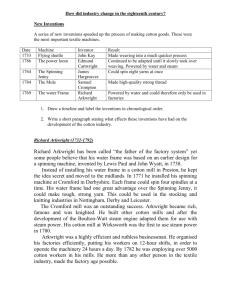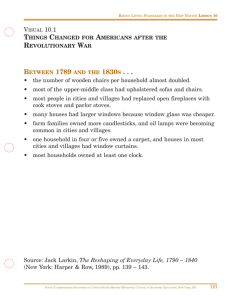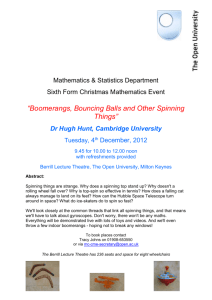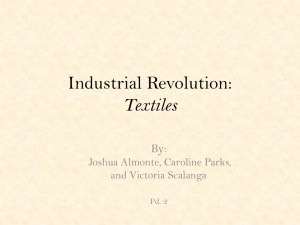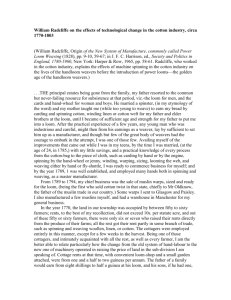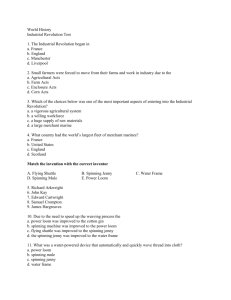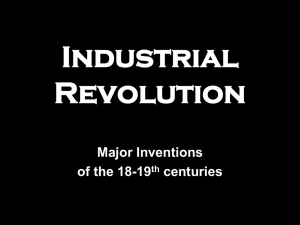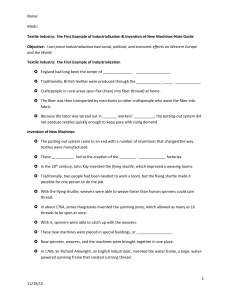1. Read the text and check the vocabulary. 2. Define the
advertisement
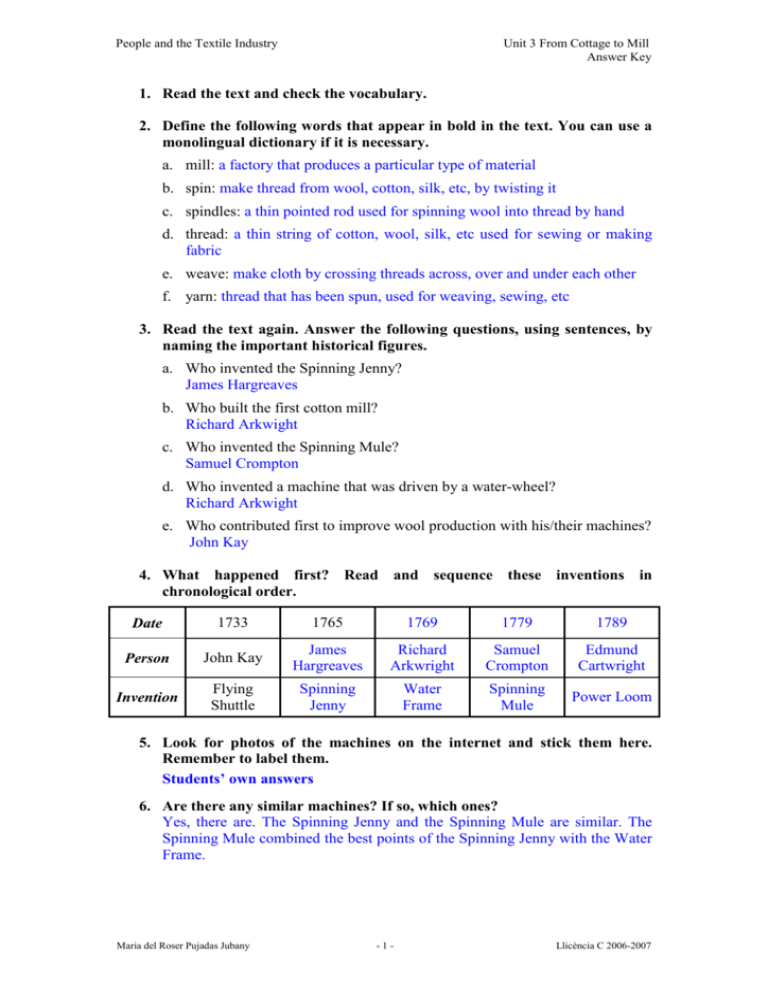
People and the Textile Industry Unit 3 From Cottage to Mill Answer Key 1. Read the text and check the vocabulary. 2. Define the following words that appear in bold in the text. You can use a monolingual dictionary if it is necessary. a. mill: a factory that produces a particular type of material b. spin: make thread from wool, cotton, silk, etc, by twisting it c. spindles: a thin pointed rod used for spinning wool into thread by hand d. thread: a thin string of cotton, wool, silk, etc used for sewing or making fabric e. weave: make cloth by crossing threads across, over and under each other f. yarn: thread that has been spun, used for weaving, sewing, etc 3. Read the text again. Answer the following questions, using sentences, by naming the important historical figures. a. Who invented the Spinning Jenny? James Hargreaves b. Who built the first cotton mill? Richard Arkwight c. Who invented the Spinning Mule? Samuel Crompton d. Who invented a machine that was driven by a water-wheel? Richard Arkwight e. Who contributed first to improve wool production with his/their machines? John Kay 4. What happened first? Read and sequence these inventions in chronological order. Date 1733 1765 1769 1779 1789 Person John Kay James Hargreaves Richard Arkwright Samuel Crompton Edmund Cartwright Invention Flying Shuttle Spinning Jenny Water Frame Spinning Mule Power Loom 5. Look for photos of the machines on the internet and stick them here. Remember to label them. Students’ own answers 6. Are there any similar machines? If so, which ones? Yes, there are. The Spinning Jenny and the Spinning Mule are similar. The Spinning Mule combined the best points of the Spinning Jenny with the Water Frame. Maria del Roser Pujadas Jubany -1- Llicència C 2006-2007 People and the Textile Industry Unit 3 From Cottage to Mill Answer Key 7. Work in pairs. Look at Sources 1 and 2 and fill in the grid below. Leave blanks if you do not know or have the information. Aspect Source 1 Source 2 1 about 9 woman women the countryside in a town or city home factory 1 more than 9 hand power steam power Name of the machines spinning wheel power loom Size of the machinery small big Number of people Sex of people Workers lived in Place of work Number of machines Power of machines windows Lighting slow fast Cloth woollen cotton Job spinner weaver Production (slow/fast) 8. Imagine you are going to research one of the women from Source 1 or Source 2. Think of eight questions you can ask about her life. One question is given to help you. Students’ own answers • • • Do you live in a town or in the country? Do you work at home? 9. Ask your partner your questions and guess where the woman works. 10. List all the jobs you know related to the textile industry. spinner, weaver, clothier, inventor, engineers 11. Group the jobs according to who did them. Remember that the same job could be done by women or men. Women Men spinners weavers weavers clothiers Maria del Roser Pujadas Jubany -2- Llicència C 2006-2007 People and the Textile Industry Unit 3 From Cottage to Mill Answer Key 12. Imagine you are a young woman living in 1815. Your family had to move from the countryside to a town some years ago. Now all of you are working in a cotton mill. Explain the changes your family has had. The following questions may help you organise your ideas. o o o o o o o o o o How long have you been living in town? Why did your family move? Where did you work and where do you work now? What were your jobs? What are your jobs? Which machines are there? Which ones do you use? Are you using hand-operated machines or steam-powered? Are the machines big or small? How many do you use? Is it hard to work there? Can you work at your own speed? Are there windows for lighting and ventilation? Do you like working there? Why? What about your family? Students’ own answers 13. Complete the following passage using the words from the box below. The invention of a reliable form of (1) power (steam) and the development of impressive new (2) machinery meant that the (3) domestic system gradually died out and was replaced by the factory (4) system. From now on, industrial (5) workers would come to the factory instead of working from (6) home. One of the first (7) industries affected by this change was (8) textile manufacture. Early (9) inventors such as Richard Arkwright had developed machines which were too (10) big to be used in the home and so were set up in factories using (11) water for power. One such (12) factory was the famous Cromford Mill in Derbyshire. However, later inventions, such as Cartwright’s Power Loom, needed steam to be effective. By the early years of the (13) nineteenth century, both cotton and wool (14) manufacture were becoming dominated by factories using (15) steam for power. (Text adapted from KELLY, Nigel, REES, Rosemary; SHULTER, Jane: Britain 1750-1900, Living through History, page 44) 14. Linking past and present. Students’ own answers a. Do you know someone who has worked as a weaver? b. If so, who? c. Where did he/she work? d. What did he/she do? e. Do you know how many looms he/she worked with at the same time? f. Are there any similarities or differences when comparing this way of working and the one shown in Source 2? List them. g. Compare your answers in groups of four. Maria del Roser Pujadas Jubany -3- Llicència C 2006-2007 People and the Textile Industry Unit 3 From Cottage to Mill Answer Key HEAR AND SAY I. II. III. IV. V. VI. VII. VIII. IX. X. XI. XII. XIII. XIV. XV. XVI. XVII. XVIII. XIX. XX. XXI. XXII. XXIII. XXIV. XXV. XXVI. XXVII. XXVIII. XXIX. XXX. XXXI. XXXII. XXXIII. XXXIV. John Kay – 1733 1733 – Flying Shuttle Flying Shuttle – loom Loom – weft yarn Weft yarn – wrap threads Wrap threads – a weaver A weaver – James Hargreaves James Hargreaves – 1765 1765 – Spinning Jenny Spinning Jenny – Water Frame Water Frame – 1769 1769 – water-wheel power Water-wheel power – first water-powered cotton mill First water-powered cotton mill – 1771 1771 – Richard Arkwright Richard Arkwright – father of factory system Father of factory system – power-driven machinery Power-driven machinery – Spinning Mule Spinning Mule – 1779 1779 – Samuel Crompton Samuel Crompton – Edmund Cartwright Edmund Cartwright – 1789 1789 – power loom Power loom - steam engine Steam engine – 1781 1781 – James Watt James Watt – Scottish engineer Scottish engineer – English manufacturer English manufacturer – Matthew Boulton Matthew Boulton – Boulton & Watt company Boulton & Watt company – Birmingham Birmingham – England England – Lancashire Lancashire – John Kay (end) (start) Maria del Roser Pujadas Jubany -4- Llicència C 2006-2007
